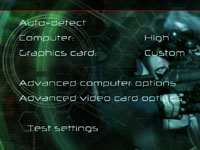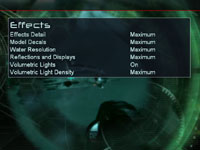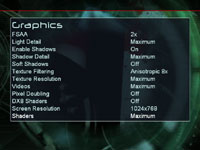EVGA e-GeForce 8800 Ultra Superclock
Written by Tim Smalley
May 31, 2007 | 15:20
Tags: #8800 #bundle #card #consumption #e-geforce #geforce #overclocking #performance #power #review #superclock #superclocked #usage #warranty

F.E.A.R.
Publisher: VU GamesWe used the full retail version of F.E.A.R. patched to version 1.08. The game makes use of a lot of effects -- including soft shadows, volumetric lighting, parallax mapping and particle effects, along with a slow-motion mode that really taxes today's top of the line GPU's. There's extensive use of high resolution textures. The walls are both bump mapped and parallax mapped to give a realistic feel to the brick walls that are a big feature of this title. Also, the world is incredibly destructible, which is made more realistic by parallax mapping.
In general, this is a graphically intense game and the most outstanding part of the graphics engine is undoubtedly the player character's shadow that is cast on the wall. It also has the most advanced A.I. that we have ever seen in a game engine to date -- there are times when you'll find yourself with your pants down around your ankles with nowhere to go.
We used the built in benchmark for our testing. Although this isn't as stressful as many portions of the game, it does give a good indication of overall game performance.
F.E.A.R.
1600x1200 4xAA 16xAF, Maximum Quality
- Nvidia GeForce 8800 GTX 768MB SLI
- ATI Radeon HD 2900 XT 512MB CrossFire
- EVGA e-GeForce 8800 Ultra Superclocked 768MB
- Nvidia GeForce 8800 Ultra 768MB
- EVGA e-GeForce 8800 GTX KO Superclocked ACS³ 768MB
- Nvidia GeForce 8800 GTX 768MB
- BFGTech GeForce 8800 GTS OC 640MB SLI
- ATI Radeon X1950 XTX 512MB CrossFire
- BFGTech GeForce 8800 GTS OC 320MB SLI
- BFGTech GeForce 8800 GTS OC 640MB
- BFGTech GeForce 8800 GTS OC 320MB
- ATI Radeon HD 2900 XT 512MB
- ATI Radeon X1950 XTX 512MB
- Nvidia GeForce 7900 GTX 512MB
-
-
103.3
-
61.0
-
-
-
102.3
-
20.0
-
-
-
100.3
-
52.0
-
-
-
94.7
-
48.0
-
-
-
93.7
-
48.0
-
-
-
85.0
-
44.0
-
-
-
78.7
-
49.0
-
-
-
75.7
-
23.0
-
-
-
75.3
-
47.0
-
-
-
63.0
-
31.0
-
-
-
60.0
-
31.0
-
-
-
59.3
-
21.0
-
-
-
56.3
-
27.0
-
-
-
45.3
-
26.0
-
0
25
50
75
100
Frames Per Second
-
Average
-
Minimum
F.E.A.R.
1920x1200 4xAA 16xAF, Maximum Quality
- ATI Radeon HD 2900 XT 512MB CrossFire
- Nvidia GeForce 8800 GTX 768MB SLI
- EVGA e-GeForce 8800 Ultra Superclocked 768MB
- Nvidia GeForce 8800 Ultra 768MB
- EVGA e-GeForce 8800 GTX KO Superclocked ACS³ 768MB
- Nvidia GeForce 8800 GTX 768MB
- BFGTech GeForce 8800 GTS OC 640MB SLI
- BFGTech GeForce 8800 GTS OC 320MB SLI
- ATI Radeon X1950 XTX 512MB CrossFire
- BFGTech GeForce 8800 GTS OC 640MB
- BFGTech GeForce 8800 GTS OC 320MB
- ATI Radeon HD 2900 XT 512MB
- ATI Radeon X1950 XTX 512MB
- Nvidia GeForce 7900 GTX 512MB
-
-
90.7
-
20.0
-
-
-
88.3
-
54.0
-
-
-
84.0
-
43.0
-
-
-
79.7
-
39.0
-
-
-
77.7
-
39.0
-
-
-
71.0
-
36.0
-
-
-
67.3
-
41.0
-
-
-
66.3
-
40.0
-
-
-
65.0
-
18.0
-
-
-
54.0
-
28.0
-
-
-
52.0
-
28.0
-
-
-
51.0
-
18.0
-
-
-
48.0
-
22.0
-
-
-
39.0
-
22.0
-
0
25
50
75
100
Frames Per Second
-
Average
-
Minimum
F.E.A.R.
2560x1600 2xAA 16xAF, Maximum Quality
- Nvidia GeForce 8800 GTX 768MB SLI
- ATI Radeon HD 2900 XT 512MB CrossFire
- EVGA e-GeForce 8800 Ultra Superclocked 768MB
- Nvidia GeForce 8800 Ultra 768MB
- EVGA e-GeForce 8800 GTX KO Superclocked ACS³ 768MB
- Nvidia GeForce 8800 GTX 768MB
- BFGTech GeForce 8800 GTS OC 640MB SLI
- ATI Radeon X1950 XTX 512MB CrossFire
- BFGTech GeForce 8800 GTS OC 320MB SLI
- BFGTech GeForce 8800 GTS OC 640MB
- BFGTech GeForce 8800 GTS OC 320MB
- ATI Radeon HD 2900 XT 512MB
- ATI Radeon X1950 XTX 512MB
- Nvidia GeForce 7900 GTX 512MB
-
-
78.0
-
57.0
-
-
-
74.3
-
16.0
-
-
-
71.7
-
41.0
-
-
-
66.7
-
39.0
-
-
-
66.0
-
37.0
-
-
-
61.3
-
37.0
-
-
-
59.3
-
45.0
-
-
-
57.7
-
16.0
-
-
-
55.7
-
42.0
-
-
-
44.3
-
25.0
-
-
-
43.0
-
25.0
-
-
-
42.0
-
17.0
-
-
-
40.0
-
22.0
-
-
-
24.0
-
13.0
-
0
10
20
30
40
50
60
70
80
Frames Per Second
-
Average
-
Minimum
F.E.A.R.
2560x1600 4xAA 16xAF, Maximum Quality
- ATI Radeon HD 2900 XT 512MB CrossFire
- Nvidia GeForce 8800 GTX 768MB SLI
- EVGA e-GeForce 8800 Ultra Superclocked 768MB
- Nvidia GeForce 8800 Ultra 768MB
- EVGA e-GeForce 8800 GTX KO Superclocked ACS³ 768MB
- Nvidia GeForce 8800 GTX 768MB
- ATI Radeon X1950 XTX 512MB CrossFire
- BFGTech GeForce 8800 GTS OC 640MB SLI
- ATI Radeon HD 2900 XT 512MB
- BFGTech GeForce 8800 GTS OC 320MB SLI
- ATI Radeon X1950 XTX 512MB
- BFGTech GeForce 8800 GTS OC 640MB
- BFGTech GeForce 8800 GTS OC 320MB
- Nvidia GeForce 7900 GTX 512MB
-
-
56.3
-
10.0
-
-
-
52.3
-
39.0
-
-
-
47.7
-
27.0
-
-
-
45.0
-
26.0
-
-
-
43.7
-
25.0
-
-
-
40.0
-
22.0
-
-
-
38.0
-
10.0
-
-
-
37.0
-
26.0
-
-
-
32.0
-
10.0
-
-
-
30.7
-
9.0
-
-
-
29.0
-
14.0
-
-
-
27.3
-
14.0
-
-
-
22.7
-
11.0
-
-
-
14.0
- 5.0
-
0
10
20
30
40
50
60
Frames Per Second
-
Average
-
Minimum
F.E.A.R. currently suffers from poor SLI scaling under Windows Vista, so this is the first time where the BFGTech GeForce 8800 GTS 640MB OC SLI configuration was actually slower than EVGA’s new flagship card. Unfortunately for the Superclocked 8800 Ultra though, CrossFire scaling works very well in this title with a greater than 75 percent performance increase from adding the second card into the fray.
The difference is actually larger than that though – it’s actually the difference between very playable and somewhat choppy gameplay. Over the period that we’ve been using and playing F.E.A.R., we’ve found that around 55-60 fps in the in-built performance test results in decent gameplay, while anything less than that can get pretty choppy in the more intense sections of the title.
As has been the case with the other titles we’ve tested this graphics card in, the performance increases over the reference clocked GeForce 8800 Ultra are incremental – in this case, you’ll see a five percent increase at 2560x1600 4xAA, but both cards don’t deliver enough frames for a good gaming experience. With only 2xAA applied, you’ll see performance gains around the 7.5 percent mark.












Want to comment? Please log in.